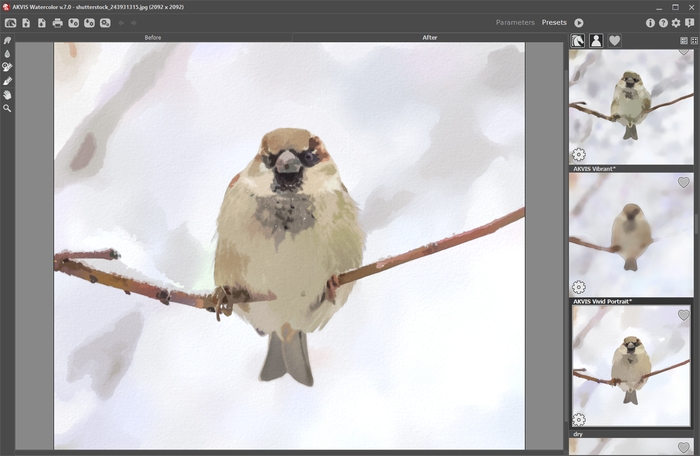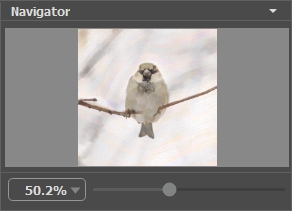Workspace
AKVIS Watercolor lets you transform a photograph into a watercolor painting. The software can be used independently as a standalone program or in a photo editor as a plugin filter.
Standalone is an independent program. You can run it in the usual way.
Plugin is an add-on for graphics editors, for example for Photoshop, AliveColors, and other compatible programs. To call the plugin, select it from filters of your image editing program.
The workspace is arranged according to the chosen interface mode: Parameters or Presets.
In the Parameters mode, the standard program window is visible.

AKVIS Watercolor Workspace (Parameters)
Click Presets in the top panel to switch to the presets visual display mode (Presets Gallery).

AKVIS Watercolor Workspace (Presets)
The left part of the AKVIS Watercolor workspace is taken by the Image Window with two tabs: Before and After. Under the Before tab, you can see the original photo. The After tab shows the resulting image. You can switch between the windows by left-clicking on the tab with the mouse button. To compare the original and the resulting images, click in the image and hold the button pressed - the program will currently switch between tabs.
In the upper part of the program's window you can see the Control Panel with these buttons:
- The button
 opens the home page of AKVIS Watercolor.
opens the home page of AKVIS Watercolor.
- The button
 (only in the standalone version) opens an image for processing. The hot-keys are Ctrl+O on Windows, ⌘+O on Mac.
(only in the standalone version) opens an image for processing. The hot-keys are Ctrl+O on Windows, ⌘+O on Mac.
Right mouse click this button to display the list of recent files. You can change the number of recent documents in the program's preferences. - The button
 (only in the standalone version) saves the image to the disk. The hot-keys are Ctrl+S on Windows, ⌘+S on Mac.
(only in the standalone version) saves the image to the disk. The hot-keys are Ctrl+S on Windows, ⌘+S on Mac.
- The button
 (only in the standalone version) calls the Print dialog box. The hot-keys are Ctrl+P on Windows, ⌘+P on Mac.
(only in the standalone version) calls the Print dialog box. The hot-keys are Ctrl+P on Windows, ⌘+P on Mac.
- The button
 loads a list of presets (.watercolor file).
loads a list of presets (.watercolor file).
- The button
 saves user presets to a file with the .watercolor extension.
saves user presets to a file with the .watercolor extension.
- The button
 (only in the standalone version) opens the Batch Processing dialog to automatically process a series of images.
(only in the standalone version) opens the Batch Processing dialog to automatically process a series of images.
- The button
 loads saved guiding lines (.direction file).
loads saved guiding lines (.direction file).
- The button
 saves the guiding lines to a .direction file.
saves the guiding lines to a .direction file.
- The button
 /
/  shows/hides the guiding lines.
shows/hides the guiding lines.
- The button
 cancels the last operation (with the tools). It is possible to cancel several operations in a row. The hotkeys are Ctrl+Z on Windows, ⌘+Z on Mac.
cancels the last operation (with the tools). It is possible to cancel several operations in a row. The hotkeys are Ctrl+Z on Windows, ⌘+Z on Mac.
- The button
 returns the last cancelled operation. It is possible to return several operations in a row. The hotkeys are Ctrl+Y on Windows, ⌘+Y on Mac.
returns the last cancelled operation. It is possible to return several operations in a row. The hotkeys are Ctrl+Y on Windows, ⌘+Y on Mac.
- The button
 initiates image processing with the current settings. The resulting image is shown in the After tab.
initiates image processing with the current settings. The resulting image is shown in the After tab.
- The button
 (only in the plugin version) applies the result to the image and closes the plugin.
(only in the plugin version) applies the result to the image and closes the plugin.
- The button
 shows information about the program: version, trial period, license.
shows information about the program: version, trial period, license.
- The button
 calls the Help files. The hot-key is F1.
calls the Help files. The hot-key is F1.
- The button
 calls the Preferences dialog box for changing the program's options.
calls the Preferences dialog box for changing the program's options.
- The button
 opens a window showing the latest news about Watercolor.
opens a window showing the latest news about Watercolor.
To the left of the Image Window there is the Toolbar. Different tools appear on the Before/After tabs.
Pre-Processing Tools (in the Before tab):
- The button
 switches on/off the Quick Preview window.
switches on/off the Quick Preview window.
- The button
 (only in the standalone version) activates the Crop tool which allows cutting off unwanted areas in the image.
(only in the standalone version) activates the Crop tool which allows cutting off unwanted areas in the image.
- The button
 activates the Stroke Direction tool used to draw the guiding lines changing direction of the brush strokes (in the Classic Watercolor style for Home Deluxe and Business licenses).
activates the Stroke Direction tool used to draw the guiding lines changing direction of the brush strokes (in the Classic Watercolor style for Home Deluxe and Business licenses).
- The button
 activates the Eraser tool used to remove or edit the guiding lines drawn with the Stroke Direction tool.
activates the Eraser tool used to remove or edit the guiding lines drawn with the Stroke Direction tool.
Post-Processing Tools (in the After tab, for Home Deluxe and Business licenses):
- The button
 activates the Smudge tool which is used to manually refine images by removing paint irregularities.
activates the Smudge tool which is used to manually refine images by removing paint irregularities.
- The button
 activates the Blur tool which reduces image sharpness by decreasing color contrast.
activates the Blur tool which reduces image sharpness by decreasing color contrast.
- The button
 activates the History Brush tool which lets you fade the watercolor effect and restore the image, partially or fully, to its original state.
activates the History Brush tool which lets you fade the watercolor effect and restore the image, partially or fully, to its original state.
- The button
 activates the Watercolor Brush tool which lets you draw translucent watercolor strokes.
activates the Watercolor Brush tool which lets you draw translucent watercolor strokes.
Additional Tools:
- The button
 activates the Hand tool which allows you to scroll the image when it does not fit within window at the desired scale. To use it, click the icon, bring the cursor over the image, and while keeping the left mouse button pressed move in the desired direction.
activates the Hand tool which allows you to scroll the image when it does not fit within window at the desired scale. To use it, click the icon, bring the cursor over the image, and while keeping the left mouse button pressed move in the desired direction.
Double-clicking on the tool's icon makes the image fit the window.
makes the image fit the window.
- The button
 activates the Zoom tool, which changes the image's scale. To zoom in left click in the image. To zoom out left click with Alt on the image. Press Z to quickly access the tool.
activates the Zoom tool, which changes the image's scale. To zoom in left click in the image. To zoom out left click with Alt on the image. Press Z to quickly access the tool.
Double-clicking on the tool's icon makes the image scale to 100% (actual size).
makes the image scale to 100% (actual size).
Navigate and scale the image using the Navigator. The frame in the Navigator surrounds the area of the image which is visible in the main window; the area outside of the frame will be shaded. The frame can be dragged, thereby changing the visible portion of the image. To move the frame, place the cursor within it, left-click, and drag.

Navigator
To scroll the image in the window you can press the spacebar on the keyboard and drag the image with the left mouse button. Use the scroll wheel of the mouse to move the image up/down, by keeping the Ctrl key pressed – to the left/to the right, by keeping the Alt key pressed − scale the image. Right-click the scroll bar to activate the quick navigation menu.
Use the slider to scale the image in the main window. When you move the slider to the right, the image scale increases. When you move the slider to the left, the image scale reduces.
You can also change the image scale by entering a new coefficient into the scale field. The fall-down menu shows some frequently used coefficients.
You can use hot-keys to change the image scale + and Ctrl++ on Windows, ⌘++ on Mac to increase the image scale and - and Ctrl+- on Windows, ⌘+- on Mac to reduce the scale.
Under the Navigator, there is the Settings Panel where you can choose the painting style (Classic Watercolor or Contour Watercolor) and its Presets, as well as tweak the parameters in the tabs:
- Painting: Adjust the settings for the watercolor effect depending on the chosen style: Classic/Contour Watercolor.
- Abstract Art: These additional settings allows you to create colorful artworks with whimsical and fantastic shapes.
- Decoration (Text/Canvas/Frame): Add text, logo or watermark to your painting, adjust the canvas surface, and apply a frame.
Under the settings, you can see Hints for the parameters and buttons when you hover over them with the cursor. You can choose where the hints will be shown or hide them in the program's Preferences.
